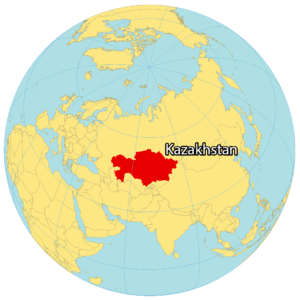Kazakhstan: an overview [2022]
Kazakhstan ranks as the largest nation in Central Asia and the world’s largest landlocked country. It share borders with Russia, China, Kyrgyzstan, Uzbekistan, Turkmenistan, and the Caspian Sea. A land of deserts and plateaus stretching across the rolling tablelands of the Eurasian landmass, approximately 20 percent of Kazakhstan is mountainous, dotted by the Tien Shan, Ulutau, and Altai mountains, among other ranges. Astana, located in the country’s northern steppes, became the capital in 1997, replacing Almaty, a city near the southeastern border. 
The nation’s abundant natural resources, considerable mineral wealth, and land resources fuel the largest economy in the region. Irresponsible exploitation of these resources, however, has generated environmental and political challenges. Kazakhstan’s extremely low population density contributes to challenges associated with economic development and environmental management.
Kazakhstan formally became a Soviet republic in 1936. It suffered enormously under the USSR’s policies and programs, nuclear testing, and devastating failures in toxic waste management over more than half a century of Soviet rule. Kazakhstan was the last of the Soviet republics to declare independence in 1991.
A Kazakh site familiar to many is the Baikonur Cosmodrome. It is situated in a remote area where the Soviets launched the first artificial satellite, Sputnik, in 1957 and Yuri Gagarin, the first human in space, in 1961, signaling the beginning of the space race. Its rocket stages and excess fuel have fallen on Russian Altai for over 50 years, a subject of significant environmental concern and controversy in that region.
ENVIRONMENTAL ISSUES
Kazakhstan faces a host of serious environmental issues. The Aral Sea, formerly one of the largest lakes in the world, has shrunk to a fraction of its size, due to Soviet agricultural policies in the 1950s that diverted water from its two river sources—the Amu Darya and Syr Darya—for cotton cultivation. The sea’s rising salinity decimated fish populations; a formerly robust fishing industry was wiped out, and the now-dry Aral seabed triggered extreme weather conditions across the region.
The legacy of Soviet nuclear testing conducted in northeastern Kazakhstan for more than four decades continues to cast a pall. Between 1949 and 1989 the Soviet Union detonated more than 110 nuclear weapons above ground at the Semipalatinsk Test Site in northeastern Kazakhstan, exposing an estimated 1.5 million people to toxic radiation. Locals still suffer from higher cancer rates and shorter life expectancy than in other parts of the country.
Kazakhstan is the largest emitter of carbon dioxide in Central Asia and the 14th in the world, a byproduct of large-scale mining, oil and gas exploration, industrial activities, and energy generation. Optimistically, Kazakhstan has come to the forefront of countries moving towards–at least in some fashion–of sustainable development, creating legislative and institutional frameworks to transition the country to a green economy.
ENDANGERED SPECIES
 A variety of animals unique to Kazakhstan or that live in Kazakhstan and other surrounding countries are at risk. Better known endangered species include the snow leopard, argali sheep, and Przewalski’s horse. Lesser known include the Tien Shan dhole (Asiatic wild dog) and Caspian Seal, among others. Persian leopards used to call Kazakhstan home, but are thought to be extirpated in the country.
A variety of animals unique to Kazakhstan or that live in Kazakhstan and other surrounding countries are at risk. Better known endangered species include the snow leopard, argali sheep, and Przewalski’s horse. Lesser known include the Tien Shan dhole (Asiatic wild dog) and Caspian Seal, among others. Persian leopards used to call Kazakhstan home, but are thought to be extirpated in the country.
Saiga antelope, once prolific on the Eurasian steppe, experienced a precipitous decline after the collapse of the Soviet Union as deregulation, contagious disease, and widespread corruption led to yo-yo-ing population levels and, ultimately, much smaller average population levels. Poachers hunted male saiga for their foot-long translucent horns, popular in traditional Chinese medicine. In 2015 a lethal bacterial outbreak killed off 220,000 of the animals. Over time, highways and other human developments have disrupted the ungulates’ habitats and movement across the landscape. The decline in saiga antelope populations has been compared to that of the American bison in the 19th century, though Kazakh populations have somewhat rebounded. The saiga is listed as critically endangered on IUCN’s Red List.
OUR WORK IN KAZAKHSTAN
Migratory birds around the globe make extraordinary journeys each year, moving between spring and summer nesting areas in the north and their winter grounds to the south, encountering numerous threats to their survival (for example, power line collisions and electrocution) en route. Birds of prey such as the Steppe eagle, Egyptian vulture, and Eastern imperial eagle travel through the Western Circum-Himalayan Migration Corridor (WCHMC) as they make their way from their nesting grounds in Russia, Kazakhstan, and Central Asia to overwinter in the Indian subcontinent, Middle East, and sometimes Africa. Data obtained from the raptors’ GPS tracker “backpacks” deployed by our partners show that a significant percentage of these birds fly at altitudes that place them on a collision course with wind turbines at the Zhanatasskaya Wind Station in southern Kazakhstan.
In May 2022 The Altai Project launched a project funded by the Critical Ecosystem Partnership Fund to address threats to raptors in Kazakhstan and to identify solutions to protect these incredible travelers.
